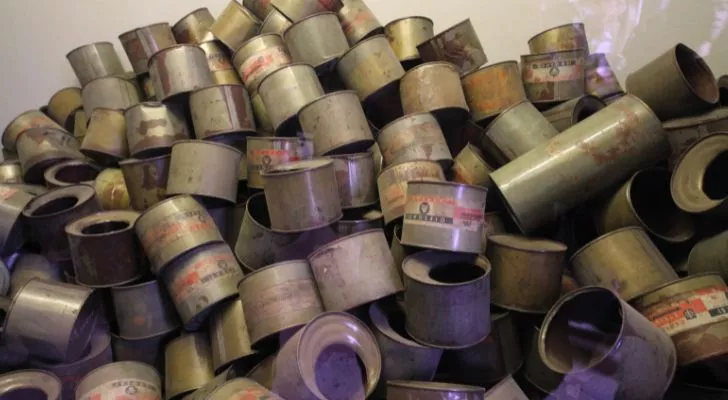Inventions have undoubtedly changed the world, completely altering our way of life. However, not every attempt to make humanity’s life easier has succeeded.
What’s even worse is that some inventions have actually left us with a bigger problem than when we started!
Whether from inventors who decided to cut corners or just flawed science, the consequences of these failed inventions persist today.
Join us as we examine stories of ingenuity gone wrong and learn the true cost of progress.
Zyklon B

German-born Jewish scientist Fritz Haber invented the process for making the cyanide insecticide called Zyklon A.
The Nazis modified his procedure and repurposed it into Zyklon B for use in the gas chambers during the Holocaust.
Among the millions of Jews who were victims of this atrocity were some of Haber’s extended family.
Chlorofluorocarbons

Refrigerators in the 1800s and early 1900s used flammable or toxic refrigerants like ammonia, sulfur dioxide, and ether.
In the 1930s, Thomas Midgely, a General Motors scientist, developed dichlorodifluoromethane, the world’s first chlorofluorocarbon (CFC), to solve the issue of toxic refrigerants.
But it created a new problem entirely.
Although CFCs are inert, once they reach the atmosphere, sunlight breaks them down, releasing highly reactive chlorine.
This chlorine then began to eat away at Earth’s ozone layer, thus depleting the Earth’s natural UV shield.
Leaded petrol

Earlier in 1921, Thomas Midgely invented leaded gasoline to improve engine performance.
At the time, people already knew of the dangers of lead, so citizens were hesitant. However, the inventors assured everyone it would be safe.
It wasn’t.
This invention caused lead contamination everywhere, including the air and soil. Consequently, there was a rise in a multitude of health conditions, such as cancer and heart disease.
This lead exposure also negatively affected the intelligence of young children and contributed to a significant rise in crime.
Plastic bags

Forbes estimates that we use about five trillion plastic bags each year. Under three percent is recycled, and the rest isn’t even disposed of properly, with a significant portion ending up in the oceans.
These bags hurt wildlife, such as sea turtles, who mistake them for food.
Another big issue with plastic bags is that they take about 700 years to start breaking down. Additionally, they release potential carcinogens into the environment.
Therefore, since their invention in 1965, plastic bags remain one of the most challenging pollutants to tackle.
Opioid painkillers

In 1806, the first pure opioid, morphine, was made by German chemist Friedrich Wilhelm Adam Sertürner.
It transformed pain management and was incredibly valuable for treating wounded soldiers during the American Civil War.
During the early days, opiates were easily accessible and marketed as non-addictive. However, by the end of the century, the dangers of opioid use had become apparent.
Despite the efforts of law enforcement agents to stop opioid misuse, the crisis rages on.
Asbestos

Technically speaking, asbestos was never invented, as it’s freely available in nature. Asbestos mining was already ongoing during the Middle Ages, but the asbestos boom officially began in the 1800s.
Asbestos was used in almost every step of the building process, including flooring, plumbing, roofing, and electrical insulation.
But it wasn’t till people started dying that we knew just how dangerous it could truly be.
It turns out that exposure to asbestos causes a severe illness called asbestosis. It’s also linked to a number of cancers, including cancer of the lungs and colon.
Despite its ban, asbestos remains a very real threat today, lurking in the structure of many old buildings.
Hydrogen blimps

Airships were initially built to fly on helium gas, which was remarkably safe and non-flammable.
The US was the world’s largest producer of helium but stopped exporting it in the 1920s for fear it would be used by enemy airships.
Germany, looking for alternatives for its airships, chose to use the highly flammable hydrogen gas instead.
On May 6, 1937, Germany’s infamous hydrogen-filled Hindenberg blimp caught alight as it docked in the US. The entire airship was consumed by flames in just 35 seconds.
Glow-in-the-dark wristwatches

Wristwatches were popularized during the First World War, but soldiers couldn’t check the time in the dark trenches. As a solution, parts of the watches were painted with a glow-in-the-dark coating.
Unfortunately, the women doing the painting in the factories did not know the danger they were exposed to.
Believing the paint was safe, they often put the paint brushes in their mouth to make a pointed tip.
The glow-in-the-dark paint actually contained radioactive radium, and this consistent exposure led to severe illnesses and the loss of over 50 lives.
Flying cars

In the early 1970s, aerospace engineering duo Henry Smolinski and Harold “Hal” Blake devised a plan to make cars that could fly like an airplane.
Their design involved adding detachable wings to the car, and they called it the Mizar. It looked brilliant on paper and reportedly had about 34 pre-orders.
However, its first outing was a failure, as the wings began detaching mid-flight, and it eventually crash-landed.
Disaster struck when the inventors took the Mizar for a spin a few months later to test a new engine. This time, the Mizar’s wings completely fell off during the flight test, and the vehicle plunged to the ground.
Sadly, the two inventors didn’t escape with their lives, and thus the project was abandoned.
Cigarettes

To be fair, people have been using tobacco in the Americas since at least 1,400 BC, especially in rituals.
It was first introduced to Europe by conquistadors returning to Spain from the Americas, but even then, tobacco was still smoked in pipes and on a much smaller scale.
Modern cigarettes were only invented around the 19th century, and it’s at this point that things got nasty.
By the end of WWI, almost everyone was smoking them, and advertisements portrayed them as healthy. But by the 1950s, studies finally linked cigarette smoking to lung cancer.
The World Health Organization (WHO) estimates that cigarettes are responsible for 7 million deaths each year. And many countries have tight regulations regarding its use.
Lobotomy

The first lobotomy was performed by Egas Moniz, a Portuguese neurologist who invented the procedure. It involved drilling a hole in the skull, inserting a pick, and pretty much just jiggling it around.
It was believed to be a miracle cure for diverse mental health conditions during the 1940s.
Despite earning the inventor a Nobel Prize, it was highly ineffective.
Lobotomies had severe consequences for some of the victims, including seizures, severe headaches, bleeding of the brain, and, in serious cases, death.
Nuclear Weapons

When they were first used during WWII, countries scrambled to build a stock of nuclear weapons.
The thing is, there’s no going back if we ever used them; a nuclear war could spell the end of mankind.
That’s not all, though.
The few nuclear devices that have been set off over the years have already done plenty of damage to the environment, the oceans, and the lives of countless people.
Synthetic fishing nets

Large-scale commercial fishing is already bad enough, but some fishing companies go one step further and dump worn-out nets into the ocean.
Since most of them are made from nylon or plastic materials, they don’t decompose.
These floating nets, called ghost nets, are a hidden danger to marine life.
Unsuspecting sea creatures like seals, dolphins, and sea turtles often get caught in these nets and sustain injuries.
Ghost nets also harm coral reefs by blocking out light from the Sun and causing them to break.
Thalidomide

Thalidomide is a sedative first made in the 1950s and marketed toward pregnant women with severe morning sickness.
It was initially considered harmless, and anyone could get it from the pharmacy without needing a prescription.
What the scientists didn’t know was that thalidomide could cross the placenta and harm the developing fetus.
It caused limb abnormalities along with other defects like visual and hearing impairment.
Thalidomide was finally taken off the market in 1961, but not before some 10,000 babies were affected.
The unfortunate reality of making scientific breakthroughs is that despite your best intentions, things don’t always go according to plan.
Sadly, the result of failed inventions doesn’t always end with the inventors. Even unintentional mishaps can affect the world for generations.
These stories of failed exploits show the importance of ethics in responsible innovation.


















